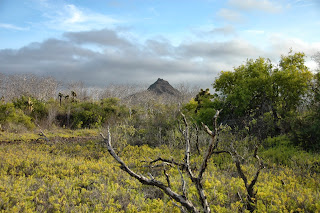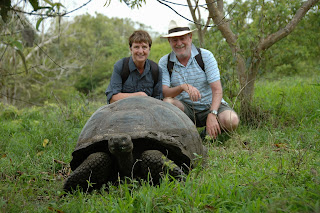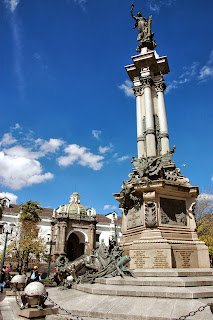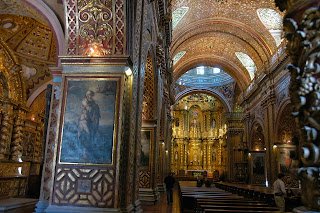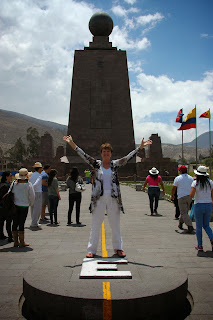We flew to the islands and
boarded Silverseas Galapgos on her maiden (post refurbishment) voyage to the
islands. We travelled the Eastern (older) islands of Santa Cruz, Seymor
Norte, Genevosa, St Cristobel and Espanola. On each island we had guides that
kept us to paths and as a result none of the animals are afraid of humans
(indeed many have few predators). This lack of fear enabled many close up
pictures (I took over 1000 in a week). This blog is centred on animals and the
next on bird life. Our voyage covered most of the islands to the East of the
“Sea Horse”.
The coastline of the islands
was spectacular with many being volcanoes
(the older ones are those that have drifted to the East). (This is not a
volcano but a quite spectacular blow hole.)
The cliffs included calderas
which assist many of the larger birds to take off.
There are limited species
most of whom have been forced to adapt to their unique surroundings. Flowers
are either white or yellow with no scent. This is because the few pollinators that are on the islands are not attracted to scent or other colours so there is no purpose in
plants being any different.
Plants and animals are generally imaginatively called
the Galapagos, Darwin or Lava something. This is the Galapagos cotton plant.
Much of the inland scenery is
unusual and not seen anywhere else. This is Dragon Hill on Santa Cruz.
One very successful plant is the prickly pear cactus, many
of which are some 200 years old. This one has suffered at the hands (well
hoofs) of introduced donkeys scratching for moisture.
A common theme on all the
islands is sea lions. The females and young have a strong bond for a year or
so (until the next pup arrives).
This is a very new pup with
the after birth still attached much to
the delight of a mocking bird.
Each harem is protected by an
Alpha male who in some cases is quite aggressive. This one took to chasing a few
of us up the beach. However, all this testosterone is difficult to maintain and
most Alphas lose their position to another male within 4 weeks. Keeps the Gene pool
strong albeit it results in many bachelor beaches where males spend a few
months recovering their energy and healing their wounds.
Many species have a symbiotic
relationship with one another. Here a beautiful yellow warbler (male as it has a
red head) is looking for small irritating insects.
This species however, is not
allowed within 2 metres of an animal so that their natural habits remain
untainted.
The islands are host to many
iguanas and uniquely there is a marine variety on many of the islands. These
feed on algae in the sea and although they are air-breathing can stay under water for
some 45 minutes. When on land they have to excrete the salt that has made its
way into their system and do this by sneezing. When they are ashore lying in
the sun and warming up it is about their
only activity.
The size varies tremendously
between islands as each species has adapted to its particular environment.
Hence marine iguanas on Genevosa were much smaller than elsewhere as there is
not so much food available. By comparison this male land iguana on Seymor Norte
does not appear to be too deprived.
And these on Santa Cruz
(South Plaza) clearly had no shortage of energy as they continued to mate and
run across the island.
They (and the seals) do seem
to have an uncanny knack of moulding to the rocks and look quite comfortable.
There were also a variety of lava lizards all of which have
evolved into a variety of sub-species which are different on each island. This
one belongs to Saint Cristobel.
One of the favourites is the
Giant tortoise which also has a sub-species on each island. This is the dome
shaped variety on Santa Cruz. Elsewhere a saddleback has evolved which occurred
as food was off the ground and required the tortoise to reach up. The front of
the shell over the years has developed a saddle appearance to enable the neck
to stretch up.
So as to put the size into perspective we used the tortoises
blind spot and crept up behind while our guide took this shot.
There are also sea turtles,
with this one becoming quite curious as we took a zodiac across the harbour
(Wreck Bay) at Saint Cristobel.
One of Helen’s favourites was the very colourful Sally
Lightfoot crab.
However, my favourite is this
lucky shot of a seal playing..





